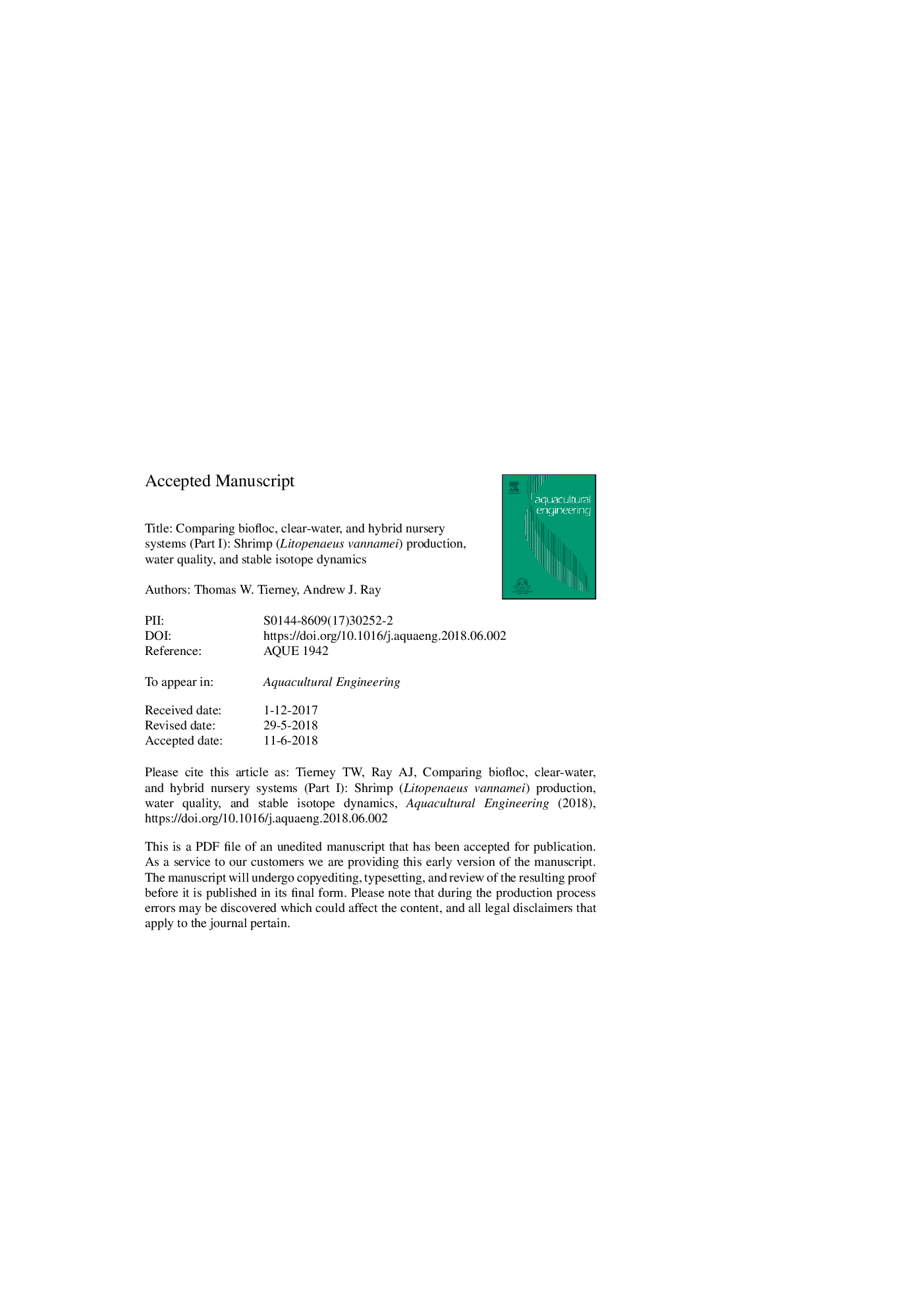| کد مقاله | کد نشریه | سال انتشار | مقاله انگلیسی | نسخه تمام متن |
|---|---|---|---|---|
| 8883495 | 1625690 | 2018 | 32 صفحه PDF | دانلود رایگان |
عنوان انگلیسی مقاله ISI
Comparing biofloc, clear-water, and hybrid nursery systems (Part I): Shrimp (Litopenaeus vannamei) production, water quality, and stable isotope dynamics
دانلود مقاله + سفارش ترجمه
دانلود مقاله ISI انگلیسی
رایگان برای ایرانیان
کلمات کلیدی
TANNO2-NL. vannameiIBWFBWMBBRBioflocClear-waterFCRSGRRASNO3-NNTUAPTdissolved oxygen - اکسیژن محلولanalysis of variance - تحلیل واریانسANOVA - تحلیل واریانس Analysis of varianceHybrid - ترکیبیDiameter - دیامتر یا قطر دایرهMoving bed biofilm reactor - رآکتور بیوفیلم تخت حرکت می کندRecirculating aquaculture systems - سیستم های آبزی پرورش مجددPacific white shrimp - میگو سفید ساحلی اقیانوس آرامspecific growth rate - نرخ رشد خاصfeed conversion ratio - نسبت تبدیل خوراکNitrate-nitrogen - نیترات نیتروژنnephelometric turbidity unit - واحد کدورت غیرفلومتریکinitial body weight - وزن اولیه بدنfinal body weight - وزن نهایی بدنPost-larvae - پست لاروtotal ammonia nitrogen - کل نیتروژن آمونیاک
موضوعات مرتبط
علوم زیستی و بیوفناوری
علوم کشاورزی و بیولوژیک
علوم آبزیان
پیش نمایش صفحه اول مقاله

چکیده انگلیسی
Indoor, intensive, nursery-based recirculating aquaculture systems (RAS) can provide high-quality juvenile shrimp for indoor or pond-based production systems in a biosecure manner. However, it is unclear what type of RAS is most appropriate for indoor shrimp nurseries. This study compared three types of RAS nurseries: biofloc (BF), clear-water (CW), and hybrid (HY). Each treatment included four, randomly assigned 160â¯L (0.35-m2) tanks that were stocked with 3000 post-larvae shrimp mâ3. The post-larvae (PL10) shrimp had an initial average weight of 7â¯Â±â¯0.0â¯mg and were grown for 48 days. The BF tanks included external settling chambers as the only filtration mechanism. The CW tanks had settling chambers, foam fractionators, and external biofilters to fully clarify the water and process nitrogenous waste. Hybrid tanks included settling chambers, and external biofilters to maintain some suspended solids along with external biofiltration. Overall, the CW treatment had significantly higher dissolved oxygen (DO) and pH levels than the BF and HY systems. The HY treatment had significantly higher DO than the BF treatment. Nitrite concentration was significantly higher in the HY treatment than the CW treatment. Turbidity in the BF treatment was significantly higher than the other treatments. On the final sample date, the BF treatment had significantly higher nitrite and nitrate concentrations than the other treatments. Differences between treatments in terms of shrimp survival, mean harvest weight, specific growth rate, and feed conversion ratio were not significant. The final weight of the shrimp at 48 days for the BF, CW, and HY were 670â¯mg, 640â¯mg, and 590â¯mg respectively. A stable isotope mixing model indicated that, in the BF treatment, 13% of the C and 34% of the N in harvested shrimp tissue may have originated from biofloc material, signifying some nutrient recycling. The nitrification process was more effective with the inclusion of an external biofilter. All three system types appear suitable for RAS shrimp nursery production although consideration should be given to water quality consistency and filtration costs.
ناشر
Database: Elsevier - ScienceDirect (ساینس دایرکت)
Journal: Aquacultural Engineering - Volume 82, August 2018, Pages 73-79
Journal: Aquacultural Engineering - Volume 82, August 2018, Pages 73-79
نویسندگان
Thomas W. Tierney, Andrew J. Ray,